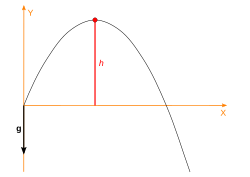Projectile motion: Difference between revisions
No edit summary |
No edit summary |
||
| Line 70: | Line 70: | ||
== Notes == |
== Notes == |
||
{{Reflist}} |
{{Reflist}} |
||
2. The angle of launch is usually show by the symbol theta but the symbol alpha is also often used. |
|||
==External links== |
==External links== |
||
Revision as of 11:16, 28 November 2012
The template {{Wikify}} has been deprecated since 25 August 2012, and is retained only for old revisions. If this page is a current revision, please remove the template.
| Template:Wikify is deprecated. Please use a more specific cleanup template as listed in the documentation. |



Projectile motion is a form of motion where a particle (called a projectile) is thrown obliquely near the earth's surface, it moves along a curved path under the action of gravity. The path followed by a projectile motion is called its trajectory. Projectile motion only occurs when there is one force applied at the beginning of the trajectory after which there is no interference apart from gravity.
The initial velocity
If the projectile is launched with an initial velocity v0, then it can be written as
- .
The components v0x and v0y can be found if the angle, ϴ is known:
- ,
- .
If the projectile's range, launch angle, and drop height are known, launch velocity can be found by
- .
Kinematic quantities of projectile motion
In projectile motion, the horizontal motion and the vertical motion are independent of each other; that is, neither motion affects the other.
Acceleration
Since there is no acceleration in the horizontal direction velocity in horizontal direction is constant which is equal to ucosα. The vertical motion of the projectile is the motion of a particle during its free fall. Here the acceleration is constant, equal to g.[1] The components of the acceleration:
- ,
- .
Velocity
The horizontal component of the velocity remains unchanged throughout the motion. The vertical component of the velocity increases linearly, because the acceleration is constant. At any time t, the components of the velocity:
- ,
- .
The magnitude of the velocity (under the Pythagorean theorem):
- .
Displacement

At any time t, the projectile's horizontal and vertical displacement:
- ,
- .
The magnitude of the displacement:
- .
Parabolic trajectory
Consider the equations,
- ,
- .
If we eliminate t between these two equations we will obtain the following:
- ,
This equation is the equation of. Since g, α, and v0 are constants, the above equation is of the form
- ,
in which a and b are constants. This is the equation of a parabola, so the path is parabolic. The axis of the parabola is vertical.
The maximum height of projectile

The highest height which the object will reach is known as the peak of the object's motion. The increase of the height will last, until vy = 0.
- ,
Time to reach the maximum height:
- .
From the vertical displacement the maximum height of projectile:
- ,
so
- .
Additional Equation
For the relation between the distance traveled, the maximum hight and angle of launch, the equation below has been developed.
References
- Budó Ágoston:, összefüggések és adatok, Budapest, Nemzeti Tankönyvkiadó, 2004. ISBN 963-19-3506-X Template:Hu
Notes
- ^ The g is the acceleration due to gravity. (9.81 m/s2 near the surface of the Earth).
2. The angle of launch is usually show by the symbol theta but the symbol alpha is also often used.
External links
- NCLab provides an interactive graphical module for projectile motion with and without air resistance.
- Open Source Physics computer model
- A Java simulation of projectile motion, including first-order air resistance
NOTE: Since the value of g is not specific the body with high velocity over g limit cannot be measured using the concept of the projectile motion.



















